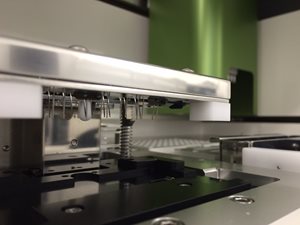 Genomic studies often compare the sequence and expression of genes between normal and diseased individuals with the aim of identifying either mutations or a particular pattern of differential expression of gene subsets that are associated with a particular disease. Genomic technologies are highly sensitive and widely used in molecular diagnostics and prognostics to not only detect and monitor disease but also to predict an individual’s risk of developing a disease. The prospect of personalised medicine, where therapies are tailored to individual patients based on their genetic makeup to increase the likelihood of success, is now possible with the advent of high-throughput next generation genomic technologies such as Next Gen Sequencing and Nanostring.
Genomic studies often compare the sequence and expression of genes between normal and diseased individuals with the aim of identifying either mutations or a particular pattern of differential expression of gene subsets that are associated with a particular disease. Genomic technologies are highly sensitive and widely used in molecular diagnostics and prognostics to not only detect and monitor disease but also to predict an individual’s risk of developing a disease. The prospect of personalised medicine, where therapies are tailored to individual patients based on their genetic makeup to increase the likelihood of success, is now possible with the advent of high-throughput next generation genomic technologies such as Next Gen Sequencing and Nanostring.
Genomics at the Westmead Institute
Our Genomics Facility is part of the Westmead Research Hub core facilities and provides four main services to Institute researchers and external customers:
Agilent Bioanalyzer
The Agilent 2100 Bioanalyzer is a microfluidics-based platform for sizing, quantification and quality control of DNA, RNA and proteins.
Library preparation for Next Generation Sequencing
The Genomics facility also offers a library preparation service for a range of Next Gen sequencing applications, including amplicon, small genome, targeted sequencing, RNA-seq and more. Libraries are prepared for sequencing on the Illumina Next Gen Sequencing platforms.
Short Tandem Repeat (STR) Genotyping Analysis
STR analysis allows identification and authentication of human cell lines, as well as detection of cell line contaminants. Cell line authentication is crucial to determine whether contaminant cell lines may be present within samples which may skew experimental results and is a requirement for many peer-reviewed journals. The Geneprint 10 system from Promega uses eight STR loci (TH01, TPOX, vWA, CSF1PO, D16S539, D7S820, D13S317 and D5S818), plus Amelogenin for gender identification for genetic profiling of cell lines. This has been recommended as the minimal requirement for cell line authentication by the American Tissue Culture Collection Standards Development Organization.
Microarray
The Genomics facility houses a Beadarray reader capable of scanning Illumina’s Sentrix Arrays. Microarray-related services provided include:
- Sample hybridization and washing
- Chip scanning
- Data analysis using Genomestudio
Technology
We offer researchers training on the following instruments:
QX200 Digital Droplet PCR
Digital droplet PCR allows absolute quantification of nucleic acid target sequences and is useful for detecting and quantifying rare targets. Applications of this technology include viral load detection, rare mutation detection, copy number variation analysis and accurate quantification of gene expression.
Nanostring
The Nanostring nCounter system allows simultaneous high precision quantitation and expression profiling of up to 800 genes and gene regulators (miRNA) in a single sample as well as allowing profiling of gene copy number variation in up to 800 regions in the human genome. The system is sensitive enough to perform single cell gene expression analysis and can generate results from challenging sample types such as formalin-fixed paraffin embedded tissue.
Covaris Evolution
Covaris technology allows focused ultrasonication and shearing of DNA/RNA for NGS and Nanostring applications, chromatin shearing for ChIP samples and DNA/RNA extraction from FFPE samples. The Evolution is a medium-throughput model, allowing 8 samples to be processed at a time.
Australian Genome Research Facility
The Sydney node of the Australian Genome Research Facility (AGRF) is located at The Westmead Institute. AGRF offers a range of services covering all aspects of genomics including Next Generation Sequencing, Sanger Sequencing, Genotyping, Gene Expression, Bioinformatics and DNA extraction.
Its mission is to provide Australia with a world-standard, research integrated, capability delivering genomic solutions to the biomedical, agriculture and environmental sectors to address key scientific questions for Australia.
www.agrf.org.au